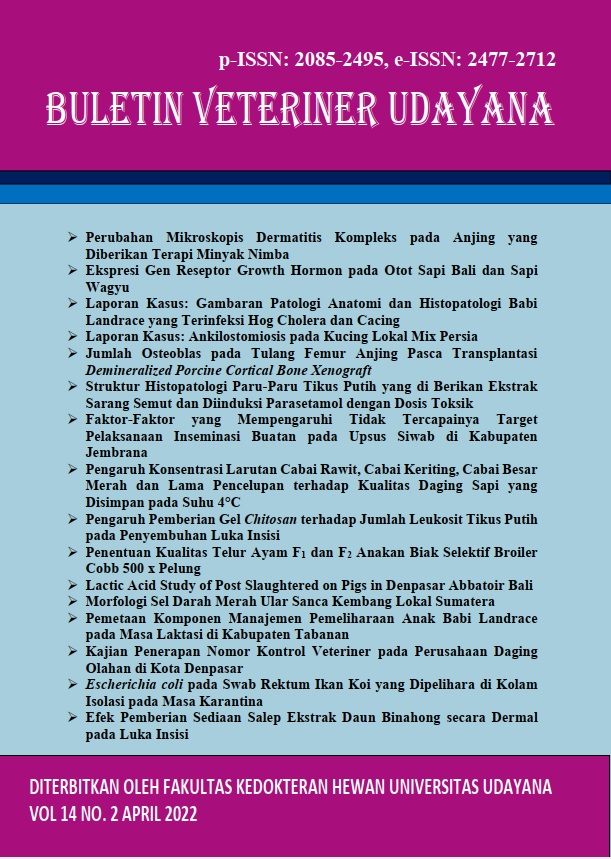HISTOPATHOLOGICAL STRUCTURE OF LUNG WHITE RAT GIVEN MYERMECODIA PENDANS EXTRACT AND INDUCED DOSAGE OF PARACETAMOL
Abstract
Myrmecodia pendan is an epiphytic plant that attaches to large trees. Myrmecodia pendans plant contains chemical compounds such as flavonoids and tannins that are known can cure various diseases. The study aimed to determine the effect of giving myrmecodia pendans extract to the histopathological lung in white rats due to the administration of toxic doses of paracetamol. This study used 24 male white rats and divided into 4 treatment groups. The histopatological changes observed were bleeding, inflammation, congestion and necrosis. The results obtained were the administration of toxic doses of paracetamol orally causes bleeding, inflammation, congestion and necrosis in the lungs of white rats. Giving extract of myrmecodia pendans can improve lung tissue due to the administration of toxic doses of paracetamol which experience bleeding, inflammation, congestion and necrosis in the white rats.
Downloads
References
Alam S, Waluyo S. 2006. Sarang Semut Primadona Baru dari Papua. Majalah Nirmala. PT Gramedia. Pustaka Utama, Jakarta.
Athersuch TJ, Antoine DJ, Boobis AR, Coen M, Daly AK, Possamai L, Nicholsona JK and Wilsona ID. 2018. Paracetamol metabolism, hepatotoxicity, biomarkers and therapeutic interventions: a perspective. Toxicol. Res. 7: 347–57.
Berata IK, Winaya IBO, Adi AAAM, Adnyana IBW. 2011. Patologi Veteriner Umum. Denpasar: Swasta Nulus.
Bill RL. 2016 Clinical Pharmacology and Therapeutics for Veterinary Technicians. E-Book. Maryland Heights: Mosby Elsevier Health Sciences.
Bhadauria M. 2012. Propolis prevents hepatorenal injury induced by chronic exposure to carbon tetrachloride. Evidence-Based Compl. Altern. Med. 2012: 112.
Bustanussalam. 2010. Penentuan struktur molekul dari fraksi air tumbuhan sarang semut (myrmecodia pendans merr. dan perry) yang mempunyai aktivitas sitotoksik dan sebagai antioksidan. Tesis. Institut Pertanian Bogor, Bogor.
Engida AM, Kasim NS, Tsigie YA, Ismadji S, Huynh LH, Ju YH. 2013. Extraction, identification and quantitative hplc analysis of flavonoids from sarang semut (Myrmecodia pendans). Ind. Crops Prod. 41: 392-396.
Eric Y, Arooj B, Moaz C, Matthew K, Nikolaos P. 2016. Acetaminophen- induced hepatotoxicity: a comprehensive update. J. Clin. Transl. Hepatol. 4(2): 131-142.
Hertiani. 2010 Preliminary study on immunomodulatory effect of sarang-semut tubers Myrmecodia tuberosa and Myrmecodia pendens. Online J. Biol. Sci. 10: 136-41.
Khalid M, Siddiqui HH , FreedS. 2011 Free radical scavenging and total phenolic content of saccharum spontaneum l. root extracts. Int. J. of Res. Pharm. Chem. 1: 1160-1166.
Kiernan JA. 2001. Histological and Histochemical Methods. 3rd Ed. Toronto. Arnold Pub. Pp: 330-335.
Soeksmanto A, Simanjuntak P, Subroto MA. 2010. Uji toksisitas akut ekstrak air sarang semut (Myrmecodia pendans) terhadap histologi organ hati mencit. J. Nature Indonesia. 12(2):152-155.
Subroto MA, Saputro H. 2006. Gempur penyakit dengan sarang semut. Penebar Swadaya. Jakarta. 2006.
Sudiono J, Oka CT, Trisfilha P. 2015. The Scientific base of myrmecodia pendans as herbal remedies. British J. Med. Med. Res. 8(3): 230-237.
Twycross R, Pace V, Mihalyo M and Wilcock A 2013 Acetaminophen (Paracetamol) J. Symptom Manage. 46: 747-755.





